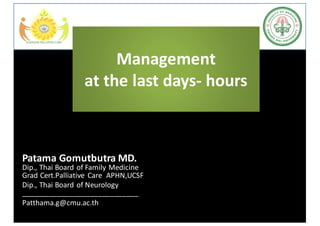Palliative_ lasthours
- 1. Management at the last days- hours Patama Gomutbutra MD. Dip., Thai Board of Family Medicine Grad Cert.Palliative Care APHN,UCSF Dip., Thai Board of Neurology _____________________________ Patthama.g@cmu.ac.th
- 3. Death and dying เสียชีวิต..เมื+อไหร่? ก. หมดลมหายใจ ข. หัวใจหยุดเต้น ค. หมดสติรับรู้ ง. หมดการตอบสนองตามอัตโนมัติ
- 4. การเสียชีวิต ทางการแพทย์ ตามประกาศแพทยสภา • มีการหยุดทํางานของระบบไหลเวียนโลหิตและระบบ การหายใจอย่างไม่สามารถฟืEนคืนสภาพได ้ • มีภาวะสมองตาย à “ก้านสมอง – brain stem” ตาย - ไม่อยู่ภายใต้ภาวะถูกกดประสาท ด้วยยา เกลือ แร่ในร่างกาย หรือ สิBงแวดล้อม - ไม่มีการตอบสนองอัตโนมัติทางประสาท (reflex)
- 5. เปลือก
- 6. • พูดน้อย คิดช ้า • สับสน จิตหลอนเป็นช่วงๆ ( delirium)
- 7. • อ่อนแรง / “ความรู้สึก” ไม่มีแรง (fatigue) • ไม่หิวอาหาร ไม่หิวนํEา (anorexia) - ร่างกายสลายไขมันและโปรตีนเป็น สารคีโตน สารยูเรีย
- 8. เมื+อเราอดอาหารและนํ8า • ปกติสมองใช ้นํEาตาลเป็นพลังงาน • หลัง 24 ชัMวโมง นํEาตาลทีMสะสมในตับจะหมดไป • ร่างกายเริMมสลายไขมันมาเป็น “สารคีโตน” และ “นํEา” • ร่างกายสลายโปรตีนเป็นอันดับต่อมา เป็น “ยู เรีย”
- 9. • กลืนไม่ได ้ มีเสียงครางจากนํEาลายทีMค ้างในปาก (death rattle) • กลไกการหายใจเรรวน ปากขยับคล ้ายหิวอากาศ ( Respiration with mandibular movement) • หัวใจใกล ้หยุดเต ้น ชีพจรคลําไม่ได ้ มือเขียวเย็น (cyanosis)
- 12. Last hours-days management L-A-S-T • Last days signs recognition • Advance care plan review & Anticipatory communication • Symptomatic comfort measurement • Transfer to home or hospice facilities
- 14. Sings of last days (within 72 hrs) Sensitivity Specificity PPS <= 20% 64 % 81 % Drooping of nasolabial fold 34% 96% Decrese respons to visaul and verbal stimuli (Decresase wakefulness) 32% 95^ Urine output < 100 ml/12 hrs 24% 96 % Hui et al, 2015r
- 16. Advance care plan review & Anticipatory communication • Review goal of care • Words to avoid • ตอนนีEหมดทางรักษาแล ้ว -> ตอนนีEเป้าหมายการรักษาคือทําให ้สุขสบาย • อยากให ้เราทํา ‘ทุกอย่าง’ หรือเปล่า -> อยากให ้เราช่วยคุณแม่เป็นพิเศษในเรืMองใด • ท่อช่วยหายใจ, นวดหัวใจฟืEนคืนชีพ -> ท่อหายใจ , นวดหัวใจฟืEนสัญญาณชีพ • เสียในวันนีEแน่นอน -> จากประสบการณ์และสถิติมีโอกาสสูงทีMผู ้ป่ วยจะเสียในวันนีE
- 17. Symptomatic comfort measurement • Terminal delirium • Decrease intake and urine output • Death rettle Respiration with mandibular movement
- 18. Terminal delirium • Multifactory, Less likely find reversible cause • Hypoactive - usually no problem • Hyperactive – Inevitable : Hope-ICU trial not support Haloperidol prophylaxis – Increasing severity (conversely with pain) – Most common cause of terminal sedation
- 19. • Antipyschotic – Haloperidol 0.5-1 mg SC/IV q 2-8 hrs (may rapid titration if symptom severe) average daily dose = 2-3 mg – Quetiapine (Seroquel) – Lorazepam not effective
- 20. Decrease intake and urine output • Anuria or gross hematuria • Depressed cardiac contractility -> low renal flow ->renal shut down • IV hydration may worsening pulmonary congestion • Consider off Foley's catheter if no concern about.. – End of life urinary incontinence – Cholinergic induce urinary retention
- 22. Background: Parenteral hydration Pro • Symbol of basic care: Bond of provider and patient • May lessen confusion,myoclonus(75% of brain weight = water) • Prevent adverse effect from high dose narcotic Con. • Interfere the acceptance of terminal condition • Unconscious patient don’t feel thirst, less pain • Less secretion in respiratory and GI tract, urine, ascites, edema • Ketone is natural anesthesia
- 23. Method • P : 129 advanced cancer prognosis about 1 week with Hx and sign of dehydration Exclude severe dehydration (eg. BP drop),CHF, active bleeding • I : SC 1000 cc per day • C : SC 100 cc per day (placebo group) • O : 0- 40 scale of dehydration symptoms (fatigue, myoclonus,sedation and hallucinations) Survival
- 24. Change from baseline Outcomes Hydrated group ( n = 44) Placebo ( n = 49) p value Dehydration symptom day 4, day 7 - Fatigue -Drowsiness - Hallucination - Myoclonus -3.3 - 4.9 -2.8 -3.8 0.77 0.54 MIDS (severity of delirium) day 4, day 7 1 2 3.5 2.5 0.06 * 0.44 BUN -2 2 0.02 * Cr -0.1 -0.1 0.25 Sodium 1.9 0.7 0.36 Calcium - 0.1 2.7 0.33
- 26. Apply to practice • In the last week of life, body may need fluid as less as 100 cc/day • Meanwhile, not more harm with 1000 cc/day • Justify for who has risk for - delirium - Hypercalcemia
- 27. Death rattle • Gurgling sound produced on inspiration and/or expiration related to airway secretions • Ineffective swallowing and cough reflex • Thin secretion – Reduce positive I/O – Hyoscine hydrobromide =Buscopan 20 mg IV q 6-8 hrs – Glycopylorate 0.2 mg IV q 8 hrs • Thick secretion – Saline nebulizure alternate with bronchodilator – Acetylcystein • Positioning
- 28. Respiration with mandibular movement • Jaw movement increases with breath • Asynchronous respiration muscle movement * not related to hypoxemia • O2 mask with bag -> not helpful but no harm relieve sense of helpless of team
- 30. Respite sedation regimen • Morphine 10 mg in NSS 100 ml IV drip start 1 mg/hr (10 ml/hr) keep BP> 90/60, RR > 10/min • If patient still awake may add Lorazepam 0.5 – 3mg/day (median dose 1 mg/day)
- 36. Transfer to home/hospice plan • Respect wish of patients most (but not all) wish to die at home • Provide advise about transporting service • ‘Hospice in hospital’ environment - Family engagement - Reconcile ritual (พิธีอโหสิกรรมข ้างเตียง)
- 37. • Most of natural pathway of dying is smooth • Last hours-days management : L – A- S-T • Last hours sign recognition • Advance care plan review + Anticipatory communication • Symptoms management • Transfer to home or hospice facilities Take home massage

